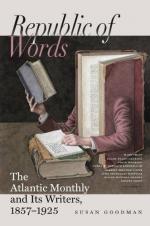These regular, every-day transformations of material elements from rock to tree, from tree to man, and back through a continual circuit, would repay us for spending our leisure hours in studying it, with our own eyes as well as with the eyes of others. The glance we have given is sufficiently suggestive to turn the attention of our readers that way. Before parting with them, however, we wish to make a few excursions into the natural world, to follow out some of the more peculiar and unexpected migrations of material atoms. Suppose we take a little marble,—which, in chemical constitution, is carbonate of lime,—that very marble, for instance, which forms the palaces of Venice, against which the waters of the Mediterranean have dashed for so many centuries, and have not dashed in vain. In their perpetual washing, they have worn away the stone and carried off its particles,—an insignificant amount, it is true, but, little as it is, it has not remained unused. For that very carbonate of lime, which once shared the proud state of the “glorious city in the sea,” now helps to form the coarse shells of oysters, or is embodied in the vast coral reefs that shoot out from the islands of the West Indies, or is deposited year after year by dying shell-fish, which are slowly carpeting the ocean-bed with their remains. Much of this same Venice marble has doubtless been appropriated by fishes from the sea-water which dissolved it, been transformed into their bones, cast upon the soil of Italy, disintegrated, and imbibed by the thirsty roots of forests in sight of the very walls from which it parted. And who can say that parts of it do not now adorn the necks of some Venetian dames, in coral, or more costly pearls? What says Ariel to the orphaned Ferdinand?
Full fathom five thy father lies;
Of his bones are coral made;
Those are pearls that were his eyes:
Nothing of him that doth fade
But doth suffer a sea-change
Into something rich and strange.
This is but a hint of the mutability of created things. Marble, sea-shells, the chalk-cliffs of Dover, the limestone fossils which preserve for us animal forms of species long since extinct, the coral formations that are stretching out in dangerous reefs in so many seas of the tropics, are all identical in their chief ingredient, and, as we see, are by natural processes and various accidents constantly interchanging their positions.
It ought to be consoling to those who think a great deal of their bodies, to reflect, that, if we may tend “to base uses,” we may also tend to very noble ones. In the course of their transmigrations, the elements of a worthless individual may get into far better company than they have before enjoyed,—may enter into brains that immortalize their owner and redeem the errors of the old possessor. Whoever bases his merit on a long line of ancestors who have nothing but a perpetuated name to boast of, may be likened to the last of many successive tenants of a house who have hired it for their temporary uses. The inheritance of a brave spirit and a noble mind is a sufficient justification for a reasonable pride; but not so with the heritage of materials which are continually interchanging with the clod.




